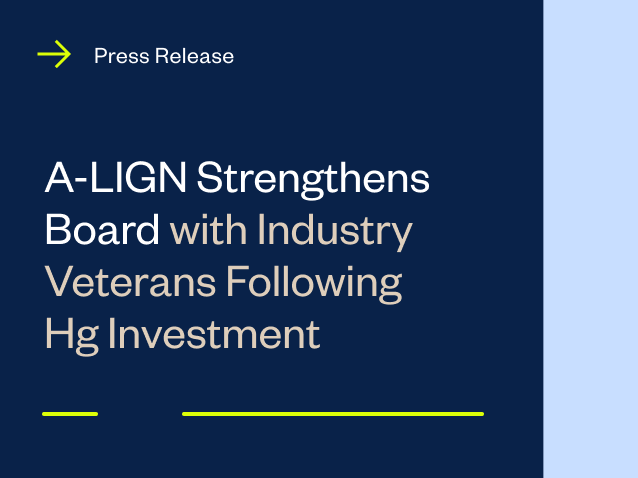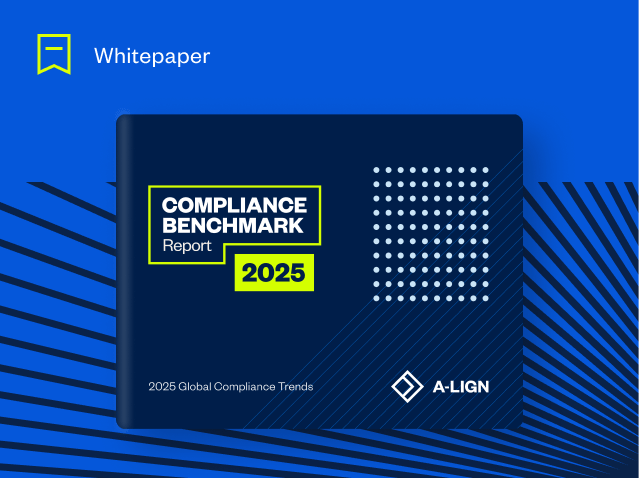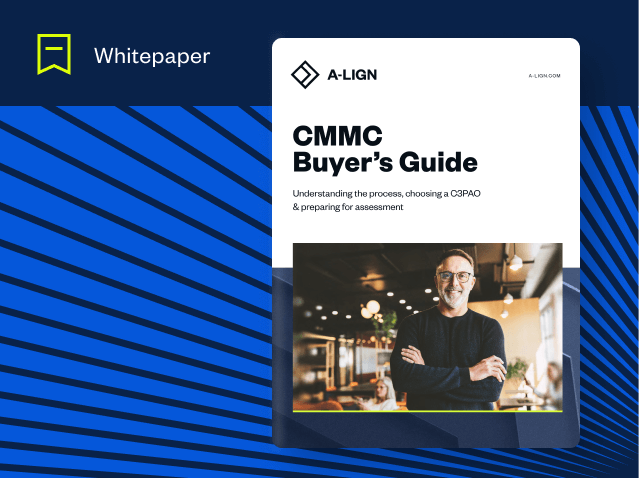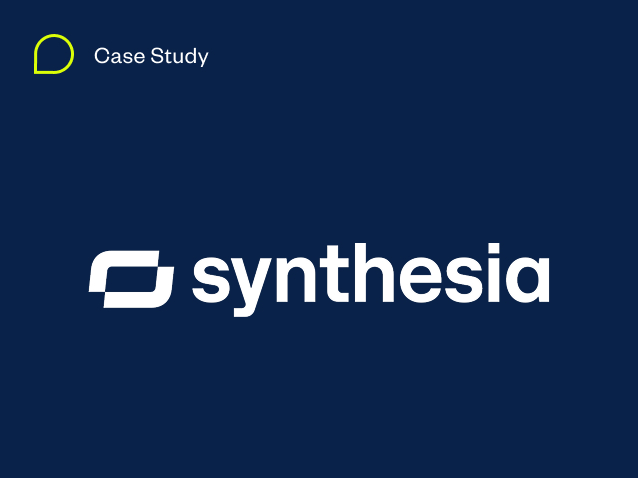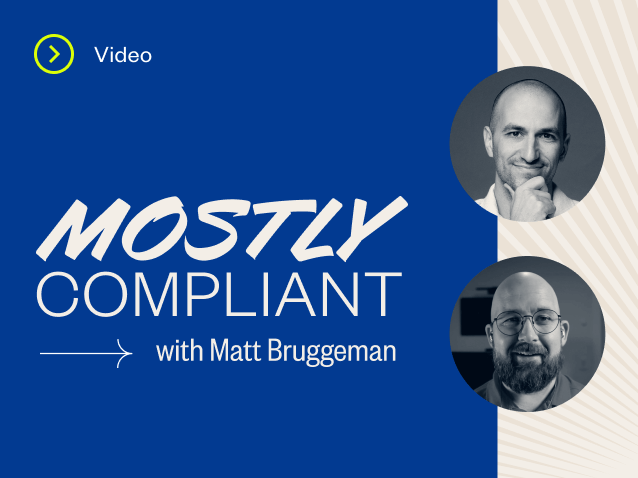Expanding your business into the American market offers a great opportunity for growth. The U.S. market offers potential, talent availability, and proximity to innovation hubs, making it an attractive place to grow your business. Plus, if you’re selling to global customers, it can give your organisation a competitive advantage over companies that don’t have an American presence.
While your business prepares for this significant milestone, there is one element you can’t forget about: compliance. Expanding into the U.S. brings all sorts of opportunities, but it also requires developing your compliance program to meet the needs of a new market.
Before committing to an expansion, it’s essential to consider the cybersecurity compliance frameworks and standards your company will need to secure to do business in the U.S. and how these will fit into your overall compliance strategy.
Compliance is a key part of your expansion plan, and it will cost you to make a misstep. Failure to comply with American frameworks can lead to lost business, broken customer trust, and worst of all, civil and criminal penalties.
In this guide, we’ll share the state of compliance the U.S. and get you up to speed on the frameworks your compliance team should focus on, plus best practices for developing a comprehensive compliance strategy for your U.S. expansion. Want to follow along? Download the complete guide. Read on to explore:
- Common frameworks and which industries they apply to
- Barriers to entry and how to get ahead of potential challenges
- How to choose an international audit partner
Common compliance standards in the United States
With the opportunity that lies in the U.S., there are many compliance frameworks to understand before you can do business in and with the country. Like many countries, the United States has its own variety of frameworks by industry.
As a baseline, understanding the frameworks that apply to your organisation is critical when preparing your expansion. Beyond this, complying with these standards sets your business up for success in a few ways:
- Competitive advantage: Many of your competitors, especially those without an American presence, won’t be compliant with the same standards you are. This gives your organisation a competitive advantage when vying for new customers in the U.S. Earning new compliance certifications isn’t just about appeasing potential customers, it’s about driving revenue for your organisation: missing certifications can mean lost business.
- Get ahead: If you’re planning to expand, getting ahead of these standards is going to help your organisation sell quicker and prepare for the flurry of activity that comes with a business expansion. Audit cycles can be long and time consuming, so it’s best to start them sooner rather than later.
- Build customer trust: Committing to new standards demonstrates to your customers that you care about protecting their sensitive information. Plus, entering a new market means your brand might not be known yet. Earning the appropriate compliance certifications can create trust with a strong security posture, giving new customers confidence in your organisation
Popular frameworks
Understanding the most popular frameworks in the U.S. and how they might apply to your organisation is a great first step to entering the market.
- SOC 1: SOC 1 reports are common for organisations that handle, process, store, or transmit financial information. This framework is common in the financial industry and ensures that clients’ financial information is protected through internal controls. The most common recipients of SOC 1 reports are payment processors, data centres, and benefits companies.
- SOC 2: SOC 2 is the most popular cybersecurity audit in the U.S. This framework is designed to protect customer data used by third-party service providers and to ensure it is stored and processed securely. A SOC 2 attestation is earned when an organisation meets a high level of security in each of the five Trust Services Criteria. A variety of organisations can be subject to SOC 2, including data centres, SaaS vendors, and other cloud computing companies.
- FedRAMP: FedRAMP is a certification required for any cloud computing provider that plans to do business with the U.S. government. This standard is designed to protect federal information stored, processed, and transmitted by government contractors. Any organisation that is currently offering, or seeking to offer, cloud products or services to a federal agency will need to successfully complete a FedRAMP assessment.
- CMMC: The Cybersecurity Maturity Model Certification (CMMC) is a newly published certification for U.S. Department of Defense contractors. This standard is designed to protect Controlled Unclassified Information, or CUI, frequently used by organisations doing business with the DoD. There are three levels of certification in CMMC that measure cybersecurity practices related to information sensitivity and threat range. This certification is required for all organisations that plan to do business with the DoD.
- FISMA: FISMA, or the Federal Information Security Modernization Act of 2014, is a federal law that requires federal agencies to develop, document, and implement a comprehensive information security program. It supports the operations and assets of the agency, including those provided or managed by another agency, contractor, or other sources. This certification is mandatory for all federal information systems and contractors that manage or process federal information.
- HIPAA: The Health Insurance Portability and Accountability Act, or HIPAA, is a common framework in the healthcare industry designed to protect individually identifiable health information. HIPAA is a U.S. law and required for any entity that stores, processes, transmits, or touches patient health information that lives in the U.S. or with U.S.-based companies. This standard can be satisfied by the controls and requirements set in place by HITRUST.
- HITRUST: HITRUST is a comprehensive, prescriptive framework designed to empower organisations in highly regulated industries, like healthcare, to build and demonstrate a mature cybersecurity and compliance strategy.
Barriers to entry and how to overcome them
Demonstrating your commitment to cybersecurity and compliance in the U.S. doesn’t have to be difficult, but there are a few barriers to entry that your organisation should be aware of before taking the leap.
Context
Understanding current and emerging frameworks in the U.S. is essential to a successful overall compliance strategy. Just as you keep an eye out for new regulations from governing bodies in your region, it’s imperative to be ready for change and understand the complete picture of U.S. compliance.
The solution? Enlisting the help of a compliance partner that has a base in the U.S. and a global presence. This will ensure you have someone in your corner who recognises the historical knowledge and overall landscape of what’s important to your organisation as you take this next step.
Audit complexity
Entering a new market means your audit cycles could become more complicated. Your team will be managing changes in priorities as your path to business in the U.S. becomes clearer. This means your organisation could need more support internally to support the increased need for documentation and organization for these new frameworks.
To avoid the pressures associated with audit complexity, consider consolidating your audits and assessments with a single provider. The audit consolidation process identifies overlaps between frameworks to reduce repetitive tasks, save time, and drive consistency. Your best bet is to work with an audit team that has an international presence and can identify overlaps to simplify your audit cycle.
Synthesizing your audits with one provider will greatly simplify your compliance strategy. If you enlist the help of an audit partner that is accredited by both American-based bodies like ANAB and EMEA-based bodies like UKAS, you’re afforded the opportunity to complete all your audits with one provider, rather than working with one auditor for your EMEA-based certifications and one for your American-based certifications. This can reduce costs and improve communication and collaboration between your organisation and your audit partner.
Customer demands
Investigate typical customer requests in advance so you’re ready when it’s time for your first sale. A U.S. company looking to buy your products and services will likely vet your security systems before onboarding you as a vendor. They may ask you to fill out security questionnaires and share documentation, reports or certifications as evidence that your security practices won’t put them in harm’s way. Understanding and preparing in advance for those requests may help you close deals faster.
How to choose an international audit partner
Choosing your audit partner for this journey is the most important step. This partner will be with you every step of the way. We recommend you consider the following:
- International presence: Choosing an auditor with an international presence is key to a successful audit cycle when you are expanding to the U.S. Look for an audit partner with a presence both in the U.S. and in your region. Your organisation will benefit from U.S. expertise without being restricted to U.S. time zones.
- Experience: Auditors with an international presence have the experience to provide you a global audit cycle, understanding the frameworks you already have and advising you on the standards you’ll need to comply with to do business in the U.S.
- Audit consolidation: Consider the complexity that an international compliance strategy will bring. Partnering with an organisation that can consolidate your audits and simplify the process is essential. Plus, using the same auditor for all of your certifications can save time and money.
- Tech-enabled: We recommend finding a partner that is tech-enabled or that can work with your chosen GRC platform. This will empower both your internal team and your audit partner to work and communicate effectively and efficiently.
- Quality audit: Finally, ensure you prioritize a high-quality report from a trusted auditor. Seek out case studies and testimonials from clients and ask a potential partner about their client satisfaction and audit acceptance rates. After all, your certification is only as good as the audit that got you there.
After you’ve evaluated potential partners and signed a contract, it’s time to begin your U.S. compliance journey!
Why A-LIGN
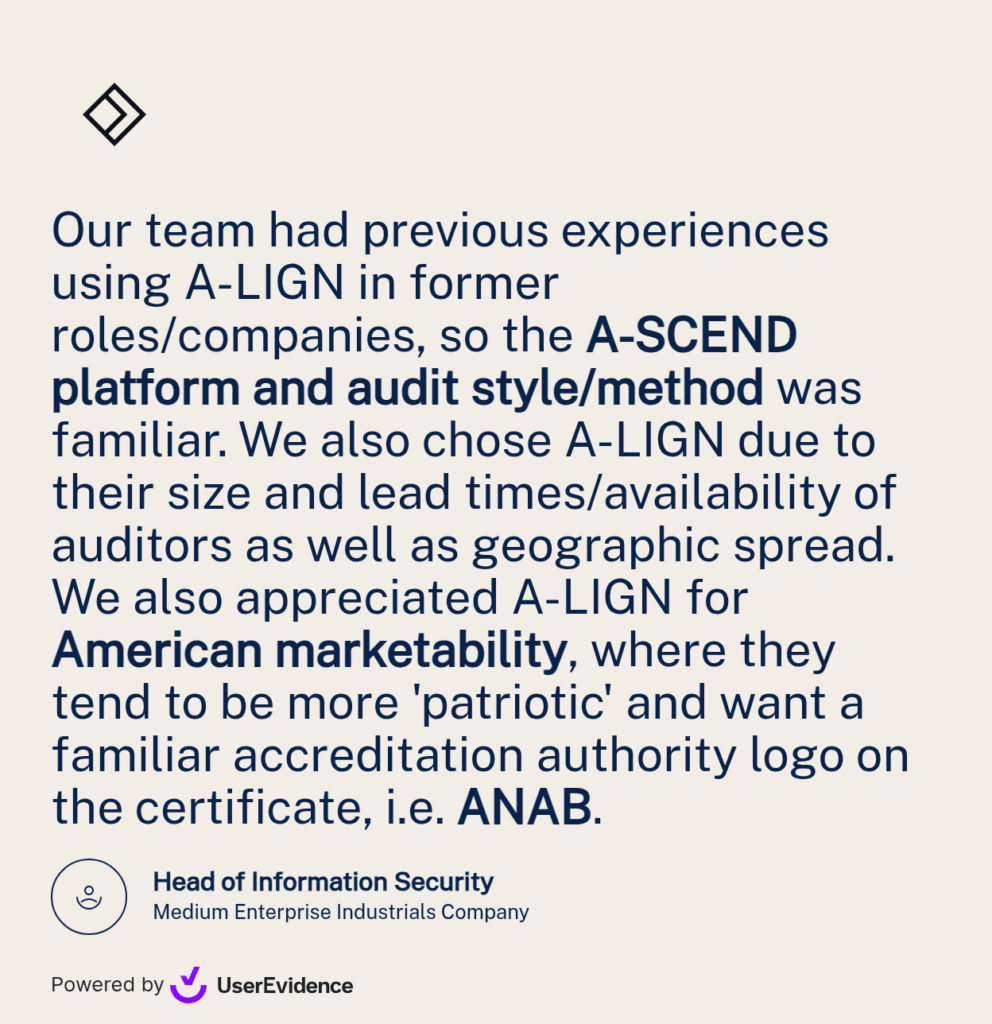
A-LIGN is a global auditor with a local footprint. We have helped more than 5,700 companies of all sizes build and scale their compliance programme with frameworks including ISO 27001, SOC 2, ISO 42001, PCI DSS and more. We also help companies comply with international regulation requirements such as GDPR, NIS2 and C5, and map their overlaps with applicable frameworks, such as ISO 27001. A-LIGN has offices in EMEA, APAC, Central America, and the U.S., plus more than 100 EMEA-based auditors, demonstrating our commitment to your global compliance strategy. We can help:
- Conduct multiple audits in a single motion: Review and reuse submissions to scale to additional frameworks – saving you thousands in resource costs. Use the evidence overlap between frameworks (such as the ~60% overlap between SOC 2 and ISO 27001) to empower you to do more with less.
- Earn compliance in the U.S. market: A-LIGN is one of a few vendors with local offices and auditors in EMEA and APAC who can offer SOC 2 and other major U.S. cybersecurity frameworks, such as FedRAMP, CMMC and others. We are in a unique position to support companies headquartered in these regions but who also operate in the U.S. market.
- Seamlessly integrate with leading GRC tools: A-LIGN partners with leading compliance automation providers, so you can leverage the technology of your choice. We also use our own technology to streamline communication, track progress, and centralise evidence collection for all audits.
Ready to learn how A-LIGN can help your organisation achieve international compliance? Contact us to get started and download the complete guide to developing a compliance strategy for your U.S. expansion.
